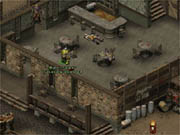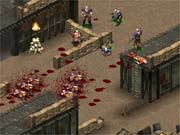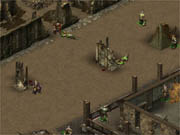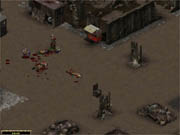Fallout Tactics: Brotherhood of Steel Developer Q&A
We talk to members of the Fallout Tactics development team to learn more about the latest game in the Fallout series.
We've been lucky enough to have spent a good deal of time with Interplay and Micro Forte's upcoming Fallout Tactics: Brotherhood of Steel, which will be published by 14 Degrees East later this year. As a result, we've become quite familiar with the game, which is evidenced by our exhaustive preview coverage. Wanting to get the deepest, most incisive perspective, though, we finally went straight to the developer--Micro Forte--and we came back with the most candid words spoken about the game yet. We spoke to a number of members of the team: Ed Orman, lead designer; Tony Oakden, producer; Karl Burdack, lead programmer; and Parrish Rodgers, lead artist. Needless to say, these guys are the biggest Fallout fans we've ever met, and their devotion to keeping the series' flavor intact is unquestionable. We got them to talk about the game's story, its mechanics and systems, their personal motivations, and the future. Our prognosis? There isn't a group of individuals more worthy of working on the Fallout series, and we can't wait to see their final product. Fallout 3 may be a long time coming, but Micro Forte and 14 Degrees East intend to help tide you over. If you're interested in the goings-on of the Wasteland, this team seems to be one to keep an eye on.
GameSpot: What can you tell us about the game's story? Aside from the mutants, who is the Brotherhood up against?
Ed Orman: The story was one of the things that evolved a lot over the first few months of the project. What we really needed was a storyline that fit into the Fallout universe but also provided us with the ability to develop tactical gameplay. That's part of the reason why we chose the Brotherhood of Steel as the main protagonists. They're a well-organized, enigmatic military group.

Because we were sending this new faction of the Brotherhood east, it followed on pretty quickly that they'd encounter the super mutants who were driven out of the area portrayed in Fallout1 and 2That let us have them as an enemy, but we never wanted them to be the ultimate opponent. So we included a batch of new enemies for the BOS, such as the reavers, as well as the nemesis of the story, whom I guess we won't be talking about just yet.
GameSpot: Who are the reavers, and what role do they play in the game?
Ed Orman: The reavers are actually similar to the BOS in a lot of ways. They're originally from prewar survivor stock, and their particular group came through with a lot of technological knowledge intact. But they lacked the driving force to keep them going and suffered some major setbacks early on. Eventually, they degenerated into more of a knowledge-worshiping society, where they treat the technology like a religion. They understand it, but they also revere it.
The problem with these guys is that they have technological know-how, but they've taken a different path, so that puts them at odds with the BOS. And, as with all conflicts, they're convinced that their way is the only way. That sets them up for some nifty conflicts later on.
However I do want to stress that neither the reavers nor the super mutants are the main bad guys.
GameSpot: You guys are obviously huge Fallout fans. What was it like working with the series? Were you allowed as much creative freedom as you'd have liked?
Karl Burdack: Overall a good experience. Actually it's hard to think of a better series to work on!
We were allowed a great deal of freedom, far more than we expected. But that didn't make it easy. We still had to make a game that remained "Fallout" but also introduced new tactical elements. The online fans have given us a great deal of useful feedback that we have acted upon, and I hope to continue this for any future titles we work on.
We also had to make numerous changes to the existing RPG system (named SPECIAL) to get the end result you now see in the demos.

Ed Orman: I love postapocalyptic games. I can't stress that enough! A lot of my early paper-based role-playing experiences were with games like Gamma World, Aftermath, and lots of home-grown end-of-the-world situations.
Fallout is a great setting. It's very distinctive and comes with loads of background material and a loyal following. Actually, that was the scariest thing about it. I knew there was a strong fan base and that we'd be treading on eggshells for the duration of the project. It's not an easy thing to keep everybody happy.
But other than those limitations, we really did have a lot of freedom. Our choice of time and place meant we could do pretty much whatever we wanted with the story, whatever worked best for a tactical game.
Tony Oakden: To be honest, when I joined the project I did not realize how vocal the Fallout fans could be! In retrospect I think it would have been easier to try and sell the Pope on contraception than Fallout Tactics to the Fallout fans! It's a shame because we really have tried to work within the limits of the Fallout universe. OK, so some of the art does not have a Fallouty feel to it, but I think it's amazing we have got as close as we have, given that this is an entirely different team from the original games. I think in retrospect we should have made the power armor more retro in style and maybe the vehicles should have been more '50s, but damn it, I like our hairy deathclaws!
Parrish Rodgers: We were given a good amount of freedom when it came to designing new features for Fallout Tactics--though all the art still had to be approved by 14 Degrees East before it went into the game. We have been bombarded with mail by Fallout fans who are concerned with the look of the new power armor, believing that it has lost its retro '50s look. Maybe it has, though just a little. We designed it so it would stand out from the original power armor and be terrifying to behold, as the Fallout Tactics faction of the Brotherhood are more ready to fight than talk. Having said that, I think we have added more to the Fallout series than we have taken away.
GameSpot: Of the games you've previously worked on, is Fallout Tactics your favorite?
Karl Burdack: Yes! But this is the first game I've worked on.
Ed Orman: Yes. I've only worked on two major titles, but FT has been a major learning experience and a lot of fun besides.
Tony Oakden: The last game I worked on was Driver for the PS, which is lucky really because it would be difficult to pick two more diametrically opposed games! So I can safely say that Driver was my favorite driving game, and Fallout Tactics is my favorite tactical combat game.
Parrish Rodgers: Fallout Tactics is by far the best game I have ever worked on. Not only is it the coolest game around, it's given me the opportunity to work with the great people at Interplay who have really helped me mature in my role as lead artist.
GameSpot: We're curious about some of the races--what incentive will one have to play as, for example, a dog or a brahmin, when other character types seem much more versatile?

Karl Burdack: The only incentive to play as a dog or brahmin will be that they are very cheap to buy in multiplayer. That's it. Ultimately the dog and brahmin are novelty races. The main races include human, ghoul, super mutant, and deathclaw. Each of these main races have different stats (strength, endurance, etc.), traits (inherent abilities), and perks (special abilities). These each offer different tactical options. The races also have built-in bonuses such as hit points and damage resistance. Finally each has a cost difference, which is the final balancing factor for multiplayer.
Tony Oakden: There are some incentives to play as dogs. They have a very high perception range, which means they should be good for detecting sneaks and traps. Trouble is they can only carry one thing and can't use weapons. But they can have good hand to hand though!
GameSpot: Was it challenging to develop a Fallout game without so much of the character interaction that players have come to associate with the series?
Karl Burdack: Yes. It led to some very tough decisions.
Ed Orman: I think the biggest problem early on was identifying what was going to work from the original games and what was going to have to be dropped. For every extra element that we left in, we were focusing less on the main gameplay requirement: tactical combat. It took us a while to sort that out. And yes, it led to some of the more controversial changes to the game.
Tony Oakden: Actually there is a lot of player-NPC [nonplayer character] interaction. We have around 90 NPC characters that speak to you throughout the game, and they all have portraits and recorded voice-overs. Most of them also have different lines of dialogue depending on what you have or have not done before you speak to them. That's quite a lot of NPC interaction for a combat-based game. So although there is no speech skill as such (and I still hold that speech skill does not really make sense when you are going into a combat situation), there are still plenty of ways for the player to influence the story progression.
GameSpot: Which of the play modes--CTB [continuous turn-based action] or turn-based--do you guys play with most around the office? Do you think each lends itself to a certain type of play style?
Karl Burdack: By far the most popular is CTB. There are a few of us that will give turn-based a go when the action gets too furious. For multiplayer we rarely play turn-based.
Ed Orman: CTB is king of multiplayer. There are people I know who will play TB: Squad if they really want to hunker down and take their time for a multiplayer match, but I like the quick and dirty battles. Turn-based comes into its own in the single-player game, as it did in the original Fallout. That's where I'll be using TB.
We also have the advantage of being able to mix the two styles. If you want to play the single-player campaign in CTB, but you find it's getting out of control, just hit the TB button and slow things down. It's a great way to get back on top of a difficult situation.

Tony Oakden: CTB. This is another thorn in our side! Sometimes I wish that I had never brought the subject up. Still, Karl invented the damn thing! With that said, now that it's in, CTB plays really well in multiplayer and single player. Some people have said that it's just a fancy name for real time. Well guess what? It is real time! That was the whole point--to open the game up to the real-time community for multiplay. But the characters' stats still have the major effect on the outcome of combat, so the RPG elements are preserved.
GameSpot: Have you had a hard time balancing the different character types and combat skills?
Karl Burdack: Combat skills were difficult. We carried over the formulas from Fallout, but it wasn't that simple. Once we got the first alpha versions of maps working, a lot of problems appeared. The end result is actually very similar to the original Fallout in concept, but the ranges and damages have all been tweaked. As an example, we have made greater contrast between weapons such as sniper rifles, semiautomatics, and shotguns, to give players interesting decisions about tactics.
Ed Orman: The character types aren't so hard, because a lot of the characters are humans who don't have any special abilities above and beyond the norm. There are the exceptions (deathclaws, super mutants) that require special balancing because of their extreme stats or abilities, but they're not too difficult. Weaponry was a much bigger job.
Tony Oakden: Balancing is always very tricky! There is bound to be some combination of weapons, skills, and stats that will provide an edge. I don't think that will matter in the single-player game. Players will play the characters they are most comfortable with just like they did in Fallout. Multiplayer is a different problem though. Still, different players will want to use different tactical approaches to combat, and we offer them the freedom to do that. I'd like to think that people will experiment and come up with ninja-style characters and highly skilled snipers and use them to give their opponents a nasty surprise.
GameSpot: Care to talk about your favorite mission and multiplayer map?
Karl Burdack: My favorite map is the demo mission 2, but some of the later missions I am looking forward to will be far superior, now that they are reaching completion. My favorite multiplayer map is our assault map. There are so many interesting tactical features in that map that we never foresaw.
Ed Orman: Everybody loves assault. We've got several multiplayer maps in the works right now that will play great. In particular, I'm looking forward to the multitiered skirmish map using the Industrial Ruins tileset. My favorite single-player map is probably the underground lair of the beast lords. Spooky, twisty tunnels, bloody slaughter rooms, and dank prisons equal cool.
Tony Oakden: Yeah, assault is my favorite multi. Like Karl, I have not had enough time to play the game and see all the final missions. Mission 4 is pretty cool (it's the first mission where the player gets to control a vehicle), as is the last mission. We've got some very amusing unique encounters as well where some familiar characters make guest appearances (if we can persuade them to show up, that is).

Parrish Rodgers: I have played a few multiplayer games with the good people from the Fallout community over the last few days, and assault would have to be my favorite multiplayer game type from the demo. I usually like to defend, as it suits the tactics I like to use, though I am getting better at attacking. I would just like to send that last sentence out as a warning to Kreegle, Dan Wood, St. Proverbius, Greg, and all the others that hang out at the Vault13 Fallout IRC channel "j00 w1ll b3 0wnz0r3d" for the next time we play.
GameSpot: Finally, are there any other Fallout games in the works at Micro Forte?
Karl Burdack: Er, if there was, then we wouldn't be allowed to say. But if the chance arose, I would jump in with no hesitation.
Ed Orman: I'd love to work on a sequel or expansion to FT. It's been a great (but tough) project. I guess we'll have to wait and see.
Tony Oakden: Well the rumor mill seems to be running overtime at the moment on all the fan sites. All I will say is that we have been in negotiation with Interplay for some time over future projects. And whatever projects we do next they will obviously draw on our existing experience.
Parrish Rodgers: I could work on games set in the Fallout universe for the rest of my career and be totally content. It's a beautifully detailed world and exciting to be a part of.
GameSpot: Thank you all for your time.
Got a news tip or want to contact us directly? Email news@gamespot.com
Join the conversation